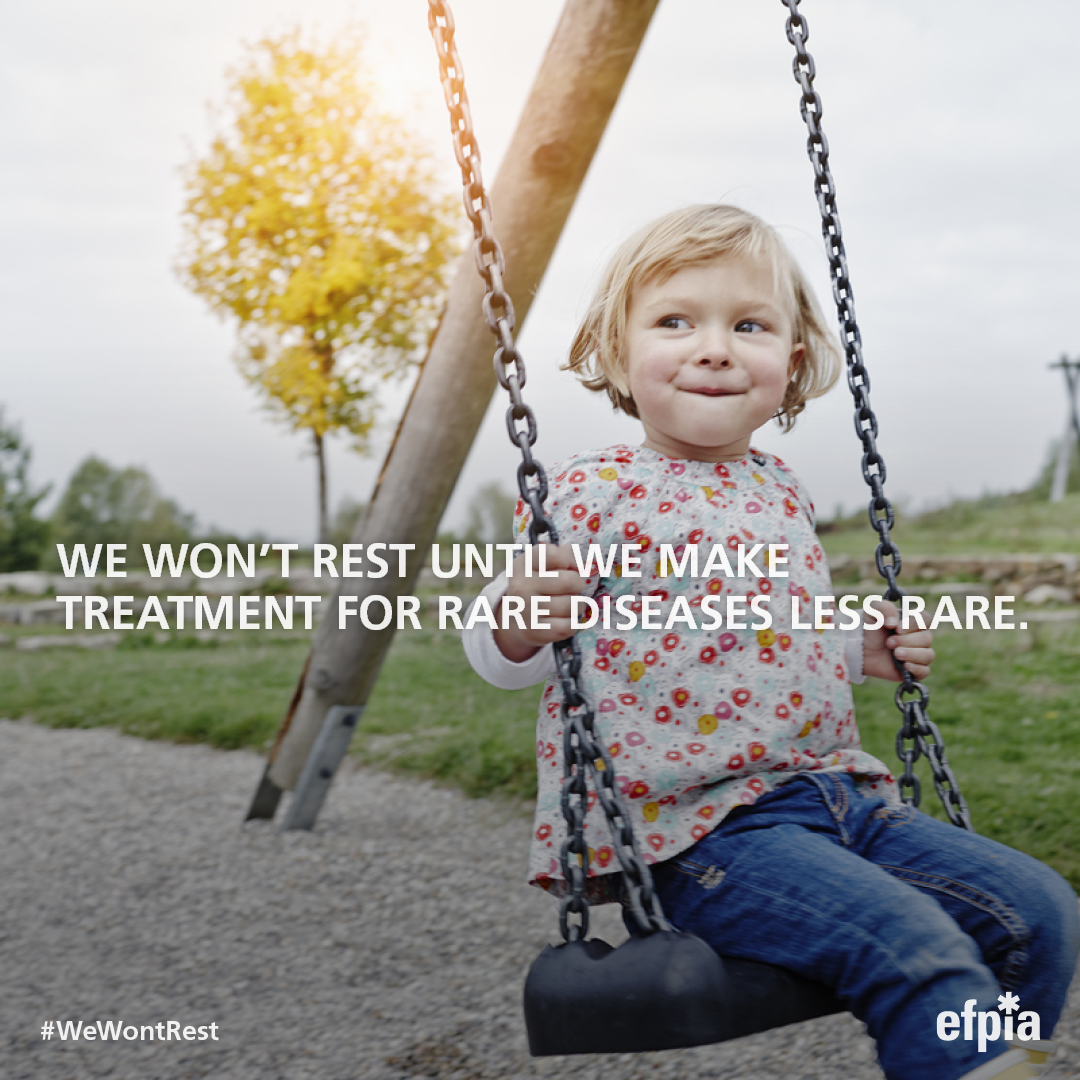#WeWontRest until we make treatments for rare disease less rare
30 million people in Europe live with a rare disease. #WeWontRest in finding ground-breaking therapies that make more and more treatments possibleGetting any diagnosis can be a shock, and shock quickly turns into questions; on prognosis, about treatment options, impact on quality of life, on family and friends. Where do I find information about my condition? How can I share experiences with other patients and learn from them? These questions will be particularly familiar to the 30 million[1] Europeans living with rare diseases. Fifty per cent of rare disease diagnoses are during childhood, meaning all those questions and worries are often carried by parents with the added burden of trying to teach, often very young, children about managing their condition.
We are working tirelessly to find new treatments for the 30 million[1] Europeans patients living with rare diseases. The number of clinical trials focused on rare diseases has increased by 88% between 2006 and 2016[2]. Research and development into rare diseases is right at the cutting edge of science and technology and pushes the boundaries of medical knowledge. At least 577 (current and pipeline) rare disease products use new technologies such as cell and gene therapies, antisense RNA interference therapy and monoclonal antibodies to precisely target the disease site[3]. In fact, a survey of approximately 180 expert physicians aimed to identify the most transformative medicines of the past 25 years; shows that of the 26 medicines identified, 10 were first developed for rare diseases[4].
For people living with rare diseases, the results of that investment have been significant - more than 2,300 new orphan designations leading to over 190 authorised new treatments [5].
When policy drives progress: Europe’s OMP legislation
The progress we see today is directly related to the implementation of the European Orphan Medicinal Products Regulation in the year 2000. “In the course of the 1990s, a number of Member States adopted specific measures to improve our knowledge of rare diseases and their detection, diagnosis, prevention and treatment[...] but initiatives in this field were few and did not lead to significant progress in research on rare diseases"[7].
Prior to the introduction of the legislation, only 8 orphan-like medicines were available for patients[8] while in just 18 years that number has risen to more than 190. European policy makers should be extremely proud of the fundamental role they have played in tackling rare diseases by developing and approving the Orphan Medicinal Products Regulation. After years of lagging behind other regions of the world that had implemented specific legislation earlier than Europe, the regulation created an environment that has fostered investment and innovation specifically in Europe, leading to a greater understanding of rare diseases and importantly to new treatments. The legislation has raised the profile of rare disease in Europe making it easier for patients to form networks thereby accessing crucial information and communicate their experience and expertise across the research and healthcare communities.
For every case where a new treatment has been developed there are however many more rare diseases where currently no treatment option exists. So much more needs to be done for the 1 in 17[1] Europeans living with a rare disease. We need to ensure a stable and predictable regulatory environment that continues to support and inspire further research into new treatments for rare disease. We need to work collaboratively across the life sciences sector, including critical SMEs on its implementation and create an environment in Europe that realises the potential of rapidly advancing science like gene and cell therapies.
Prior to the introduction of the legislation, only 8 orphan-like medicines were available for patients[8] while in just 18 years that number has risen to more than 190. European policy makers should be extremely proud of the fundamental role they have played in tackling rare diseases by developing and approving the Orphan Medicinal Products Regulation. After years of lagging behind other regions of the world that had implemented specific legislation earlier than Europe, the regulation created an environment that has fostered investment and innovation specifically in Europe, leading to a greater understanding of rare diseases and importantly to new treatments. The legislation has raised the profile of rare disease in Europe making it easier for patients to form networks thereby accessing crucial information and communicate their experience and expertise across the research and healthcare communities.
For every case where a new treatment has been developed there are however many more rare diseases where currently no treatment option exists. So much more needs to be done for the 1 in 17[1] Europeans living with a rare disease. We need to ensure a stable and predictable regulatory environment that continues to support and inspire further research into new treatments for rare disease. We need to work collaboratively across the life sciences sector, including critical SMEs on its implementation and create an environment in Europe that realises the potential of rapidly advancing science like gene and cell therapies.
Access today, hope for the future
There are two parts to the OMP access equation:
- Access for the people living with 95% of rare disease where there are no treatment options
- Access for patients living with the 5% of rare conditions where a treatment exists
That means developing the next generation of treatments that can transform the lives of patients and help address the challenges faced by our healthcare systems and secondly, ensuring access to existing medicines, a goal and responsibility we share with governments and health systems.
Of course the potential of these new treatments can only be realised if patients have access to them and in our experience, everyone in the healthcare eco-system; the patients, their families and carers, clinicians, payers, health systems and the companies that develop the new treatment all share the goal of access.
Of course the potential of these new treatments can only be realised if patients have access to them and in our experience, everyone in the healthcare eco-system; the patients, their families and carers, clinicians, payers, health systems and the companies that develop the new treatment all share the goal of access.

There are two key components to ensuring patient access to new treatments. The first is navigating Europe’s regulatory process. The second is to go through national pricing and reimbursement procedures before a new treatment can be given to patients and reimbursed by health systems.
In Europe, our industry, regulators and health systems need to work together to make new treatments available to patients faster. From the regulatory perspective, that means maintaining Europe’s world class regulatory system, making the most of real world evidence and advances in data analytics to evolve our systems and processes to keep pace with the rapidly advancing science and changing treatment paradigms.
In Europe, our industry, regulators and health systems need to work together to make new treatments available to patients faster. From the regulatory perspective, that means maintaining Europe’s world class regulatory system, making the most of real world evidence and advances in data analytics to evolve our systems and processes to keep pace with the rapidly advancing science and changing treatment paradigms.
Once a treatment is licensed for use in Europe, industry, healthcare systems and governments share the responsibility of ensuring that patients get access to the new treatment. There has been significant progress:
- by 2014, 20 European countries had developed national rare disease plans[9].
- A number of countries across Europe have adapted HTA[10] and reimbursement practices specially designed to address the questions posed by the introduction of orphan medicines into the system.
- Companies too, are bringing forward solutions to support patients’ access to new medicines. Flexible approaches such as managed entry agreements were implemented between 2006 and 2012 across a number of European Countries for 26 orphan medicines, featuring innovative approaches such as performance-based arrangements or financial-based agreements.
Despite the progress, healthcare systems continue to raise concerns about managing the introduction of new treatments, particularly in the case of cell and gene therapies which can replace a life-time of care with a one-time treatment but where the costs are borne by the health system upfront. Clearly this is immensely challenging for health systems already under pressure from increased demand for their services.
It is here where our industry, healthcare systems and governments need to find new ways to finance these treatments that ensure access for patients and sustainability for health systems. We share the goal of fast, equitable and sustainable access to treatments and recognise the disparities and delays in access for patients across Europe. Addressing these issues requires a shared, evidence-based understanding of the root causes of shortages, barriers and delays in access to treatments. We believe it is time for different type of conversation and EFPIA supports the EU Health Summit’s call for a multi-stakeholder High-Level Forum on Access and Healthcare Transformation[11] to bring all actors together to discuss how to ensure access to new treatments and technologies today, medical innovation for tomorrow and sustainable healthcare systems in a globally competitive Europe.
Right policy, right priority
Right policy, right priority
For patients living with rare disease, it is critical that we find the right policy solution for each priority.
Addressing the needs of the 95% of patients living with rare disease where no treatment option exists means standing by the OMP regulation to drive further research in to the next generation of treatments and cures.
To ensure patients get access to these new treatments is a different discussion which has to include regulators, health system partners, industry, and governments in finding collaborative approaches to support access to and availability of treatments for rare disease. We believe that a High-Level Forum on Access and Healthcare Transformation would be the ideal vehicle to address these issues in partnership.

Choosing the wrong policy tool to address an issue will have a negative impact on people living with rare diseases both now and in the future. For example, trying to address issues of access and availability to new treatments through an OMP Regulation designed to create new treatment options will not improve access now and will harm access in the future for the 95% of patients where no treatment option exists today.
- #WeWontRest until we make treatments for rare disease less rare get_app
- Addressing unmet needs in extremely rare and paediatric-onset diseases - how the biopharmaceutical innovation model can help identify current issues and find potential solutions get_app
- Challenges and facilitators in the development of orphan and paediatric medicines get_app
[1] EURORDIS. Available at: http://www.eurordis.org/about-rare-diseases
[2] Evaluating the Orphan Regulation and its impact on patients and rare disease R&D in the European Union. Available at: http://www.pugatch-consilium.com/reports/Benchmarking_success.pdf
[3] Groft SC. Chest. 2013;144(1):16–23
[4] Kesselheim A and Avorn J. Nature Reviews Drug Discovery. 2013;12;425–31
[5] EMA. Available at: https://www.ema.europa.eu/en/documents/report/annual-report-use-special-contribution-orphan-medicinal-products-2020_en.pdf
[6] Evaluating the Orphan Regulation and its impact on patients and rare disease R&D in the European Union. Available at: http://www.pugatch-consilium.com/reports/Benchmarking_success.pdf
[7] European Commission. 2015. Inventory of Union and Member State incentives to support research into, and the development and availability of, orphan medicinal products — state of play 2015
[8] Office of Health Economics, 2010. Available at: https://www.ohe.org/publications/assessment-impact-orphan-medicinal-products-european-economy-and-society. Accessed: Feb 2017
[9] Rodwell C and Ayme S. Biochimica et Biophysica Acta 1852. 2015;2329–35
[10] Health Technology Assessment
[11] A shared vision for health, Paving the Way in 2019, recommendations in Full. EU Health Coalition 2019